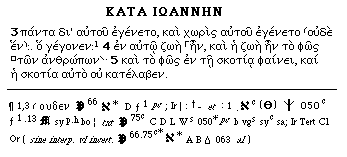In order to decipher the notes in the critical apparatus, you may either place the cursor over the symbols in the critical apparatus or click on the individual characters. If you click on the characters, you will be brought to the description of that object in the table below. To return to viewing the apparatus, click on the up arrow icon to the left.
 |
||
 |
The words enclosed between these two signs are replaced by other words in a part of the tradition. |
|
 |
||
 |
||
 |
||
 |
||
 |
||
 |
||
 |
||
 |
||
 |
||
 |
||
 |
||
 |
||
 |
The parenthetical citation of witnesses in the critical apparatus indicates that these witnesses attest unequivocally the readings in question, but that they also exhibit certain negligible variations which the restrictions of space preclude describing in detail. Codex Koridethi, Ninth Century |
|
 |
||
 |
||
 |
A family of manuscripts which is valued as one witness. |
|
 |
||
 |
sy refers to the Syriac versions: p is the Peshitta (5th cent.) and h is the Harclean (6th cent.). |
|
 |
The Bohairic is a Coptic version of the New Testament. |
|
 |
The different readings in a single instance of variation are separated by a broken vertical line. |
|
 |
The witnesses for the reading printed in the text are preceded by the sign txt (= textus). |
|
 |
Papyrus 75, late second century. The superscript c refers to a correction in the text. |
|
 |
Codex Ephraemi, fourth century. |
|
 |
Codex Bezae, sixth century. |
|
 |
Codex Regius, eighth century. |
|
 |
Codex Washingtonensis, supplement, fifth century |
|
 |
050, Ninth Century |
|
 |
pauci (a few): A few other witnesses. |
|
 |
||
 |
The Sixtine edition of the Curetonian Syriac version, fifth century. |
|
 |
||
 |
Church Father: Irenaeus, Second Century |
|
 |
Church Father: Tertullian, Third Century |
|
 |
Church Father: Clement of Alexandria, Second Century |
|
 |
Church Father: Origen, Third Century |
|
 |
||
 |
Papyrus 66, Second Century |
|
 |
Papyrus 75, late second century. The superscript c refers to a correction in the text. |
|
 |
Codex Sinaiticus, Fourth Century |
|
 |
Codex Alexandrinus, Fifth Century |
|
 |
Codex Vaticanus, Fourth Century |
|
 |
Codex Sangallensis, Ninth Century |
|
 |
||
 |
[Home] [Textual Criticism] [Index]
